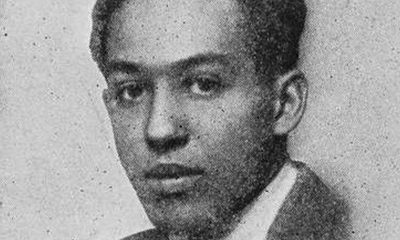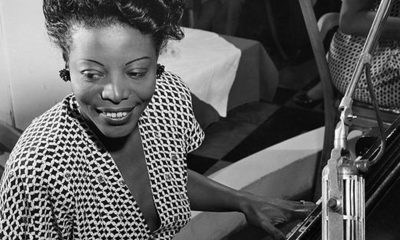Black History
Sheryl Swoopes, The Little Dribbler
Raised by her mother in Brownsville, Texas, young Sheryl Swoopes played basketball with her three older brothers. By age seven, she was competing in a local kid’s league, the Little Dribblers. It was her siblings, she said, that helped her hone her game. “At first, they didn’t like playing with me,” she told the Los Angeles Times. “Then when they did, they wouldn’t play hard. But eventually one brother, James, played ball at Murray State. He’s 6-4. He wouldn’t play hard until he saw how good I was getting, when I beat him a couple of times.”

By Tamara Shiloh
In April 1996, women’s basketball announced: “We Got Next.”
The WNBA was approved by the NBA Board of Governors, and games would begin the following year. The inaugural season proved successful as more than 50 million viewers watched the games.
Six months after the announcement, the league signed its first player, Sheryl Denise Swoopes (b. 1971–). In 1997, she was recruited for the Houston Comets. The signing of the contract had been long anticipated, far from the days when a girl turning pro seemed an impossible dream.
Raised by her mother in Brownsville, Texas, young Sheryl played basketball with her three older brothers. By age seven, she was competing in a local kid’s league, the Little Dribblers. It was her siblings, she said, that helped her hone her game.
“At first, they didn’t like playing with me,” she told the Los Angeles Times. “Then when they did, they wouldn’t play hard. But eventually one brother, James, played ball at Murray State. He’s 6-4. He wouldn’t play hard until he saw how good I was getting, when I beat him a couple of times.”
Over time, competing with her brothers increased her confidence, making her eager to test her skills on the blacktop. Swoopes made the basketball team at Brownfield High School, where she developed into an All-State and All-American high school player.
“It helps to play with the guys,” she told the Washington Post. “They’re so much more physical than girls are. Once you go out and you play with guys, and you get in a situation with girls, you think, ‘Well, if I scored on that guy, I know I can score on her.’”
Six feet tall by high school graduation, Swoops stood among the most popular college recruits. Her choice: University of Texas at Austin. It was the only school she seriously considered, yet she’d never given the 400-mile distance much thought.
“It was a big national basketball power, and I thought they could take my game to another level. But once I got there … well, I just didn’t realize how far it was from home,” she said. Homesick, after four days she returned home, relinquishing her full scholarship.
Determined to take her game to another level, Swoops ignored the naysayers predicting her career was already over. She enrolled in South Plains Junior College in Levelland, Texas. There, after her second season, she was named National Junior College Player of the Year. Basketball, going forward, was an uphill climb.
In 1993, Swoopes won the NCAA women’s basketball championship with the Texas Tech Lady Raiders. She has won three Olympic gold medals, an NCAA Championship, and a WNBA title. She was elected to the Naismith Memorial Basketball Hall of Fame in 2016. In 2017, she was inducted into the Women’s Basketball Hall of Fame.
Share Swoopes’ story about the game with your young daughter. Read “Shattering the Glass: The Remarkable History of Women’s Basketball,” by Pamela Grundy and Susan Shackelford.
Activism
Oakland Post: Week of April 24 – 30, 2024
The printed Weekly Edition of the Oakland Post: Week of April 24 – 30, 2024

To enlarge your view of this issue, use the slider, magnifying glass icon or full page icon in the lower right corner of the browser window. ![]()
Activism
Oakland Post: Week of April 17 – 23, 2024
The printed Weekly Edition of the Oakland Post: Week of April 17 – 23, 2024

To enlarge your view of this issue, use the slider, magnifying glass icon or full page icon in the lower right corner of the browser window. ![]()
Black History
Matthew Henson: Explorer Extraordinaire
Matthew Henson, a trailblazing explorer who overcame countless obstacles to leave an incredible mark on history. Born on August 8, 1866, in Charles County, Maryland, his journey is a testament to the power of determination and the spirit of adventure.

By Tamara Shiloh
Matthew Henson, a trailblazing explorer who overcame countless obstacles to leave an incredible mark on history. Born on August 8, 1866, in Charles County, Maryland, his journey is a testament to the power of determination and the spirit of adventure.
Henson’s life began amidst the backdrop of post-Civil War America, where opportunities for African Americans were scarce. From a young age, he possessed an insatiable curiosity about the world beyond his small town. At the age of 12, he embarked on a journey that would change the course of his life forever when he joined a merchant ship as a cabin boy.
His most famous expedition was his journey to the Arctic with renowned explorer Robert E. Peary. In 1887, Henson joined Peary’s crew as a seaman and quickly proved himself to be invaluable with his skills as a navigator and craftsman. Over the course of several expeditions, Matthew endured extreme cold, treacherous terrain, and grueling conditions as he and Peary sought to reach the elusive North Pole.
In 1908–09, Peary set out on his eighth attempt to reach the North Pole. It was a big expedition, with Peary planning to leave supplies along the way. When he and Henson boarded their ship, the Roosevelt, leaving Greenland on August 18, 1909, they were joined by a large group. This included 22 Inuit men, 17 Inuit women, 10 children, 246 dogs, 70 tons of whale meat, blubber from 50 walruses, hunting gear, and tons of coal.
In February, Henson and Peary left their anchored ship at Ellesmere Island’s Cape Sheridan, along with the Inuit men and 130 dogs. They worked together to set up a trail and supplies along the way to the Pole.
Peary picked Henson and four Inuit people to join him in the final push to the Pole. However, before they reached their destination, Peary couldn’t walk anymore and had to ride in a dog sled. He sent Henson ahead to scout the way. In a later interview with a newspaper, Henson recalled being in the lead and realizing they had gone too far. The group turned back, and Henson noticed his footprints helped guide them to their destination. At that location, Henson planted the American flag.
Henson’s legacy extends far beyond his expeditions to the Arctic. He shattered racial barriers in the world of exploration and inspired countless individuals, regardless of race, to dream big and pursue their passions. In 1937, he was finally recognized for his achievements when he was inducted into The Explorers Club, an organization dedicated to promoting scientific exploration and field research.
Matthew Henson died in the Bronx, New York, on March 9, 1955, at the age of 88.
-

 Community2 weeks ago
Community2 weeks agoFinancial Assistance Bill for Descendants of Enslaved Persons to Help Them Purchase, Own, or Maintain a Home
-

 Activism3 weeks ago
Activism3 weeks agoOakland Post: Week of April 3 – 6, 2024
-

 Business2 weeks ago
Business2 weeks agoV.P. Kamala Harris: Americans With Criminal Records Will Soon Be Eligible for SBA Loans
-

 Community2 weeks ago
Community2 weeks agoAG Bonta Says Oakland School Leaders Should Comply with State Laws to Avoid ‘Disparate Harm’ When Closing or Merging Schools
-

 Activism2 weeks ago
Activism2 weeks agoOakland Post: Week of April 10 – 16, 2024
-

 Community1 week ago
Community1 week agoOakland WNBA Player to be Inducted Into Hall of Fame
-

 Community2 weeks ago
Community2 weeks agoThe Year Ahead: Assembly Speaker Rivas Discusses Priorities, Problems
-

 Community1 week ago
Community1 week agoRichmond Nonprofit Helps Ex-Felons Get Back on Their Feet























































